The computer is electronic and can perform arithmetical and logical operations at high speed with incredible accuracy.
The computer system was generally used for calculation purposes.
In this article, we will learn about the Differences Between Third and fourth Generation of Computers with their characteristics, features, examples, and images.
What is the Third Generation of Computers?
The 3rd generation of computers was developed in 1964 – 1971.
These generations of computers were far more advanced than their counterparts as they used and utilized Integrated Circuits IC as their main component.
The IC was advanced technology at that time and therefore increased speed and efficiency, outsmarting the other computers in the market.
The 3rd generation computers were faster, smarter, and user-friendly compared to second-generation computers.
The Integrated Circuit was invented by Jack Kilby, an electrical engineer from Texas Instrument Company, on 12th September 1958.
The invention of IC was a stepping stone toward the further development of the computer system.
The integrated circuit made computers small in shape and size, eventually making them portable compared to other generation computers.
They produced less heat and energy; also, their electric consumption was pretty low.
This generation of computers extensively used operating systems also utilized high-level programming languages like COBOL and FORTRAN.
What is the Fourth Generation of Computers?
The fourth generation of computers was designed and developed from [1971 - 1985].
They used microprocessors as their main component and installed them in their circuit, which enhanced the overall performance like speed, accuracy, efficiency, and reliability.
The microprocessor increased the computer’s speed, making them multitask, and multiprogramming eventually increased the overall performance.
These qualities made 4th gen computers rule the computer industry for decades.
These generations of the computer used high-level technology like VLSI [Very Large Scale Integration].
Using microprocessors, microcomputers were developed, which were later termed “Personal Computers”.
They are highly portable and can quickly transfer from one location to another.
These 4th generations of computers were more reliable and user-friendly than other generations.
The first personal computer was designed and developed by IBM Company in 1974.
They also used high-level programming languages like C, C++, Visual Basic, Python, and SQL Servers.
In 1984 APPLE designed and developed a computer named Macintosh and an operating system for better usability.
They also used input and output devices like mouse, printers, and keyboards for better performance.
They can also perform arithmetic and logical operation with high speed and incredible accuracy.
Computer 4th generations used object-oriented programming, and these techniques are used and utilized in JAVA, PHP, PYTHON, .NET, and Visual Basic.
Fourth-generation computers are used in data management, report generation, software development, GUI development, web development, and research.
Differences Between Third and Fourth Generation of Computers Info-Graphics
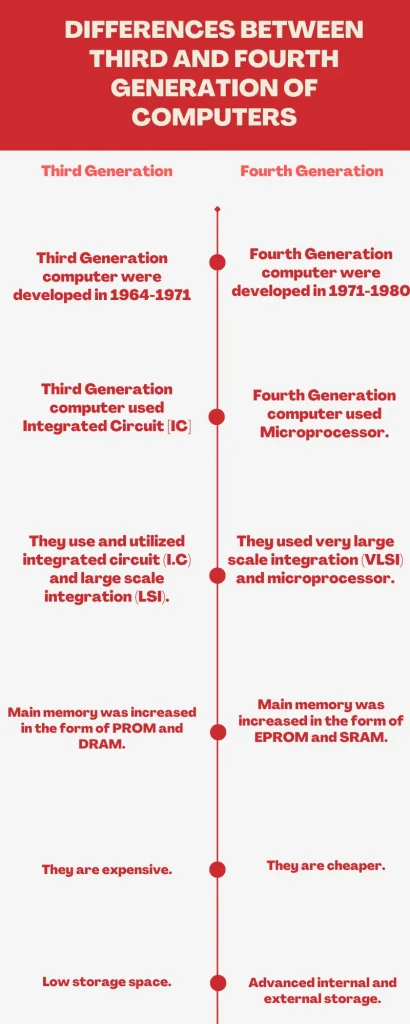
Differences Between Third and Fourth Generation of Computers in Tabular Form
| # | Third Generation | Fourth Generation |
| 1 | Third Generation computers were developed from 1964-1971 | Fourth Generation computers were developed from 1971-1980 |
| 2 | Third Generation computers used Integrated Circuit [IC] | Fourth Generation computers used microprocessors. |
| 3 | BASIC, COBOL, Pascal, FORTRAN, C, C++, Perl, and Ada. | Perl, Python, Ruby, SQL, MatLab (Matrix Laboratory). |
| 4 | They are slower than fourth-generation computers. | They are faster computers. |
| 5 | They are expensive. | They are cheaper. |
| 6 | Low storage space. | Advanced internal and external storage. |
| 7 | Generated heat and consumption of electricity were high. | Produced less heat and energy, less consumption of electricity. |
| 8 | The Speed of Third Generation Computer was around 100 Nano Seconds. | The speed of the 4th generation computer is measured in Picoseconds. |
| 9 | The 3rd generation computers used Integrated Circuit [IC] and it was designed and developed by Jack Kilby. | In 1971, Intel released the 4004 microprocessor. |
| 10 | Less Portable | Highly Portable. |
| 11 | They are called “Mini Computers”. | They are called “Micro Computers”. |
| 12 | They use and utilized integrated circuits (I.C) and large-scale integration (LSI). | They used very large-scale integration (VLSI) and microprocessor. |
| 13 | Main memory was increased in the form of PROM and DRAM. | Main memory was increased in the form of EPROM and SRAM. |
Five Generations of Computer Systems
- First Generation of Computer (1940-1956)
- Second Generation of Computers(1956-1963)
- Third Generation of Computers(1964-1971)
- Fourth Generations of Computers:: ( 1971-To 2000)
- Fifth Generations of Computers (Present and Beyond)
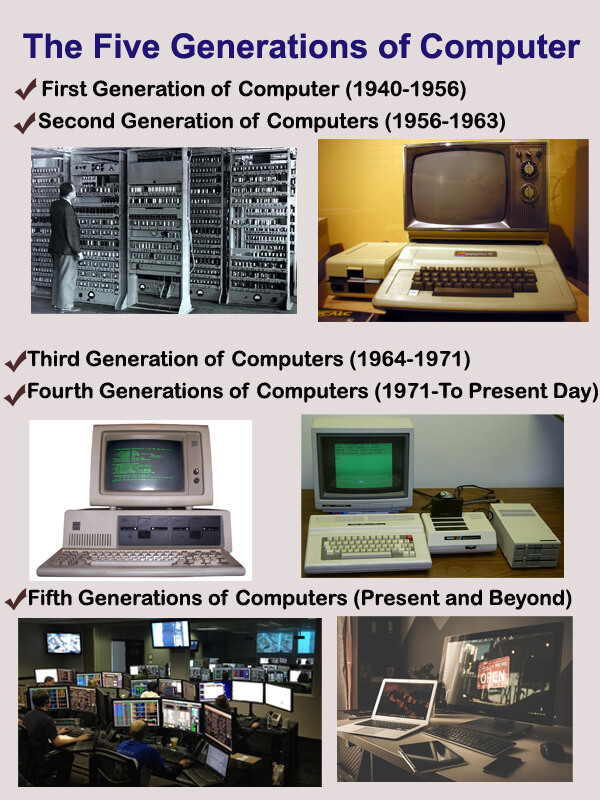
Examples of Third Generation of Computers
- IBM-360 Series
- Honeywell – 6000 series
- PDP (Personal Data Processor)
- IBM-370/168
- TDC-316
- UNIVAC 1108
- ICE
- PDP-8
- PDP-5
- PDP-1
- Barose-5700/6700/7700
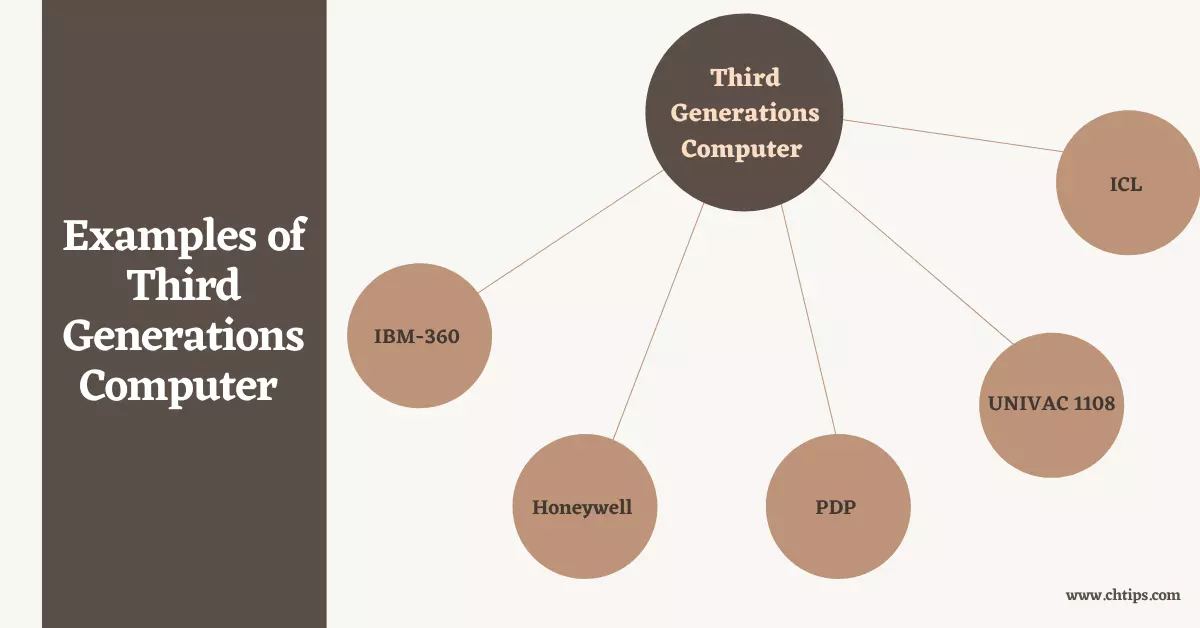
Characteristics and Features of Third Generations of Computer
- Third-generation computers use integrated circuits [IC].
- They are more user-friendly machines and therefore used extensively.
- They are compact and hence can be installed in small spaces.
- High-level programming languages like C, C++, Python, PHP, etc.
- They are multitasking and multiprogramming.
- Advanced internal and external storage mediums are found in the third-generation computer.
- They emitted less heat and energy.
- VLSI {Very Large Scale Integration} and ULSI {Ultra Large Scale Integration} chips were used for compact design.
- The main memories in 3rd generation computers were developed to hold crucial data and information for faster processing, increasing the speed.
- VLSI {Very Large Scale Integration} and ULSI {Ultra Large Scale Integration} chips were used for compact design.
- Consumption of less electricity.
- The third generation of the computer system used an Integrated circuit which is more advanced technology than vacuum tubes.
- Transistors made computers compact.
- They are highly portable compared to other generations of computers.
- They consumed less power and electricity.
- They emitted less heat and energy.
- Multitasking and multiprogramming.
- They are reliable and user-friendly.
- High-storage internal and external storage devices.
- They use high-level programming languages.
- They are faster machines and devices compared to their counterparts.
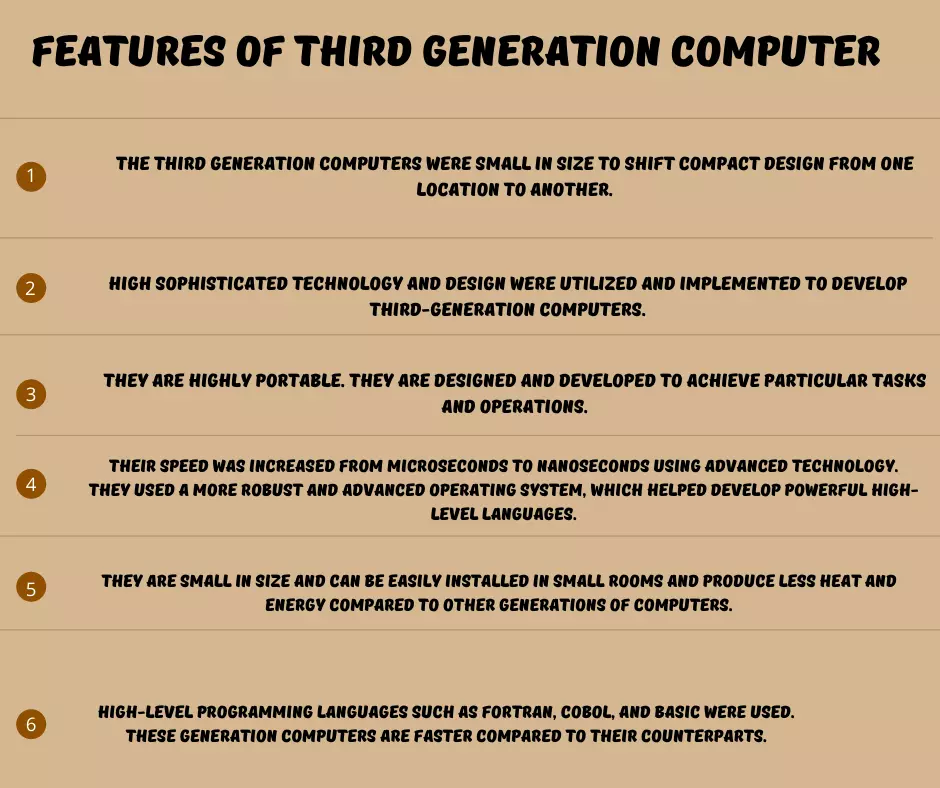
Disadvantages of Third Generation of Computers
- They are expensive.
- The design and architecture are very complex.
- They are not considered home or personal computers.
- The Integrated Circuit is a sophisticated technology.
- Skilled professionals are required for maintenance
- The components and devices are expensive.
- They are designed and developed for specific tasks and operations.
Languages Used in Third Generation of Computers
BASIC, COBOL, Pascal, FORTRAN, C, C++, Perl, and Ada.
Examples of Fourth Generation of Computers
- PDP 11
- Macintosh
- CRAY-1 (Super Computer)
- CRAY-X-MP (Super Computer)
- IBM 4341
- DEC 10
- STAR 1000
- ZX – Spectrum
- Intel Pentium
- AND
- Apple II
- STAR 1000
- PDP 11
- CRAY2
- CRAY Y-MP
- CRAY Y-MPC
- IBM 4341
- IBM PC
- VAX 9000
Characteristics of Fourth Generation of Computers
- The development of the microprocessor made a vital impact on the development of the computer industry.
- The speed of the fourth generation of computers is far more advanced than other generations of computers.
- Input and output devices made them very popular.
- They have equipped me with advanced internal and external storage.
- They consume less power and electricity.
- They do not produce heat and energy; therefore, an air conditioner was not mandatory.
- They are more reliable and user-friendly machines.
- The development of more advanced systems and application software made them easier to use and handle.
- They used and utilized microprocessors as a significant component.
- 4th generation computers used VLSI chips.
- They used semi-conductor memory for better performance.
- Advanced application software can work with these generations of computers like spreadsheets, documents, words, media players, etc.
- They can work with GUI [Graphical User Interface].
- They are less expensive and therefore are affordable to the general public.
- They are portable due to their compact size.
- They used high-level programming languages.
- They are multitasking and multiprogramming with the time-sharing concept.
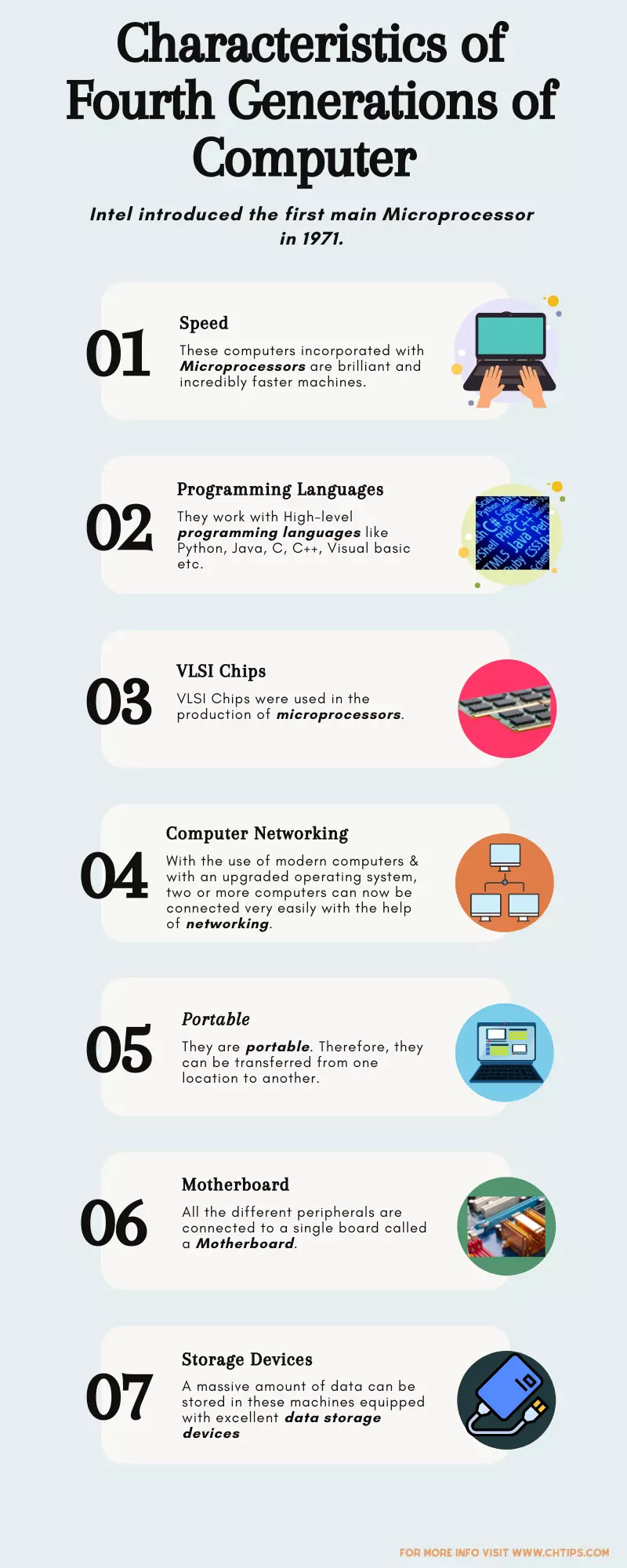
Languages Used in Fourth Generation of Computers
Perl, Python, Ruby, SQL, MatLab (Matrix Laboratory).
Computer Full Form
| C | Commonly |
| O | Operated |
| M | Machine |
| P | Particularly |
| U | Used for |
| T | Technical and |
| E | Educational |
| R | Research |
All Generation of Computer [1st To 5th]
| # | Computer Generations | Timeline | Hardware |
| 1 | First Generation of Computer | 1940-1956 | Vacuum Tubes |
| 2 | Second Generation of Computer | 1956-1963 | Transistor |
| 3 | Third Generation of Computer | 1964-1971 | Integrated Circuit (I.C.) |
| 4 | Fourth Generation of Computer | 1971-1980 | Microprocessor |
| 5 | Fifth Generation of Computer | 1980- Till Now | Artificial Intelligence |
Differences Between Third and Fourth Generation of Computers [YT]
Related Articles
- Advantages and Disadvantages of Computer
- Advantages and Disadvantages of Fifth Generations of Computer
- Advantages and Disadvantages of First Generation Computer
- Characteristics and Features of Third Generation Computer
- What is Versatility In Computer System
- Essential Attributes of Good Software
- Smallest Unit of Computer Memory Storage
- How Do Computers Works at the Most Basic Level
- 12+ Characteristics of Fourth Generations of Computer
- Advantages and Disadvantages of Fifth Generations of Computer
- What are the Five Generations of Computer System?
- Explanation on a Brief History of Computers
- 10 Characteristics and Features of Second Generation Computer
- What are the Five Generations of Computer System?
- Advantages and Disadvantages of Second Generations of Computer
- Fourth Generation of Computers With Characteristics, Advantages, Examples and Uses
- 11 Advantages and Disadvantages of Third Generation of Computers
- 11 Differences Between Second Generation and Third Generation Computer
- Differences Between First and Second Generation of Computers
- Advantages and Disadvantages of Fourth Generations of Computer
- Advantages and Disadvantages of Supercomputers
- Computer Basic Tutorials
Frequently Asked Questions [FAQs]
What is the Speed of Third Generation Computers?
The Speed of Third Generation Computer was around 100 Nano Seconds.
Who Invented the 3rd Generation Computer?
The 3rd generation computers used Integrated Circuit [IC] and it was designed and developed by Jack Kilby.
What is the Memory of Third Generation Computers?
Semiconductor Memory.
What is the Speed of a 4th Generation Computer?
The speed of 4th generation computer is measured in Picoseconds.
When was the Fourth Computer Made?
Fourth Generation Computers used and utilized microprocessor which was developed in 1972.
What Memory is the 4th Generation?
Magnetic Core Technology.
Who Invented the 4th Generation of Computers?
In 1971, Intel released the 4004 microprocessor.
Get In Touch
I have also written and compiled some articles on computers and telecommunications, and please go through them.
I hope you will like reading it.
I hope that all the questions and queries related to Differences Between Third and Fourth Generation Computers System have been answered here.
If you have any questions related to the Pros and Cons of 3rd and 4th Generation of computers.
Don’t hesitate to contact me, and if you need to add, remove, or update anything from the article, please let me know in the comment section or via email.
I will be more than happy to update the article. I am always ready to correct myself.
I was hoping you could share this article with your friends and colleagues; this motivates me to write more on related topics.
!!! Thank You !!!